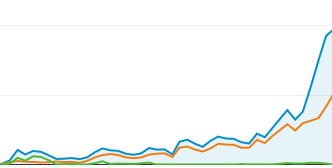How Well-Meaning Web Designers Destroy Google Rankings, Profits and Businesses

Contents
You hire a digital marketer to improve your site’s visibility by optimising your pages to rank higher for your target keyword phrases and it takes off.
You watch your traffic and sales increase month on month and start to visualise how big your company can really get – with all that extra revenue from a whole world of potential new customers, thanks to the web, your hard work and the insider knowledge your search engine optimisation specialist has worked.
You see continuous online growth that generates a steady increase in sales…

Then disaster…

You invest some of your increased revenue in a new, more modern looking site or theme and after a month of teething problems, you see a big drop in traffic and sales.
Then a few months of slow decline you are back to where you started 5 years ago.
Where did all your traffic go? What did your new web designer do to screw things up so badly?
Ask them and they won’t have a clue why nobody comes to the site anymore. I mean, if they were interested in the number of traffic and sales your site generated they would have become a marketer, not a designer.

That’s right, usually, most web designers don’t have a clue what went wrong, but it makes no difference to them, your new site is on their portfolio page and it looks good, so what if you don’t hire them again. They got what they needed and the site they created for you “looks” just like the one you agreed on.
You might stick with them and put your hopes in the fact that it might be a glitch with Google, or that they uncover a mistake they made that they can correct. But don’t hold your breath.
It turns out that they likely made one of the 5 most common errors that cause sites to drop off the map and cause businesses to suffer, even die.
The above images of web traffic are not just anecdotal, they are actual records of the decline suffered by a client of mine. During the previous year or so I had implemented a successful Search Engine Optimisation campaign and built on it to generate ongoing growth from increasing Google traffic. They loved it. And it was this that provided the increased revenue they decided to spend on, not further marketing, but a whole new site. Spot the mistake?
Of course, we wanted to protect this upward trend at all costs, so when the client decided to have the website completely rebuilt we made sure their chosen web designer agreed to make sure the site was designed to look like the client’s mock-up and also to ensure that 3 important considerations were implemented properly:
1 – that all of the web page urls would remain exactly the same, or simply redirected
2 – that all the optimised meta data was copied from our campaign spreadsheet and pasted into the new web pages – and
3 – that the internal linking structure remained similar to how it was on the existing site
However, it was on completion of the job the client soon realised that the ‘designer’ not only failed to implement the 3 main items on the spec list but also went ahead and launched the new site before it had been approved and signed off. Yep, even Google indexed the new faulty site before we even saw it.

Worse was that when asked why he failed to implement the 3 SEO considerations, he was happy to argue that they didn’t matter to the design.
It was at this stage that the client realised that he was not only either lazy or incompetent but had a few personal issues that left him still in denial that the new site he replaced the existing site with, was to blame for the loss of pretty much all of the client’s rankings and traffic.
This was a heart-breaking experience for the client to say the least. Not only did he trash their site and launch an incomplete replacement but they had to stay loyal and friendly to him until they regained full access to the server and domain – which if lost, would make it impossible for any other designer or marketer to fix.
So, because this isn’t the first time a designer has implemented a quick pre-built WordPress theme, launched the site, received payment then washed their hands of the client, below we cover 5 of the main errors that he single-handedly destroyed the firm’s main revenue source with.
First, take a look at the main questions you should ask to see if your web designer knows about SEO and how much you value your traffic. Then use the below as a checklist if you find your new site has lost rankings and traffic and always be sure to have an SEO or digital marketer oversee the work done by website designers.
Error 1 – they have changed your web page’s urls
Your site has built up domain authority and page authority on the specific urls your web pages could be found at. All those years of building up ranking power on these urls is lost as soon as your web designer decides to change your url structure without redirecting every url. The most common url structure changes that will destroy your hard earned Google rankings are:
- Changing from http to https urls
- Changing from www to non www urls
- Changing to urls with trailing slashes
- Changing from html, php or aspx urls
For example all of the example homepage addresses below are completely different and Google treats them as such. Switch between them without adequate redirection rules and you will lose all your built up page authroity, your Google rankings and the majority of your traffic:
http://example.com
http://example.co.uk
http://example.co.uk/
http://example.co.uk/index.htm
http://example.co.uk/index.html
http://example.co.uk/index.php
http://example.co.uk/homepage/
Obviously if you change the address of any of your pages they will need to be permanently redirected to the new urls, and if you change your entire domain from say, http://example.co.uk to https://www.example.co.uk, then you will have the same task ahead of you.
Its an easy fix to create the redirects, simply crawl all the old urls before the site changes then map each one to new urls once it is live, then use simple redirect rules to redirect each url. In the case of http to https or non-www to www changes, simply add a rule in the hidden .htaccess file that redirects the whole lot in one go. Test them and you are done.
Your web designer likely doesn’t know or care about the change because everything seems to be working on the site and broken link tools will report that there are no broken links on the site. Below though is what you need to know in order to make sure they can recover all the ranking power your site has achieved from the incoming links they dropped during the site rebuild.
For any web designers out there who actually care about their clients business, here is how to fix the mess you likely just made…
- Set up Google search console and paste the Google Analytics tracking code back into the site – which you likely forgot to do
- Pull a list of all the crawl error urls google search console is screaming out for you to fix
- Pull a list of all the linked to pages urls from Google search console you are unaware of
- Sign up to a free trial of Majestic, Ahrefs or SEMrush and pull a list of all the the urls that have incoming links to them, importantly – be sure to include historic incoming links, so you grab all those high authority urls from years back
- Compile all those urls into a spreadsheet, sort them alphabetically and note if any are https / http or are non www or www, even check the file extensions, just so you know the valuable property you almost threw away
- Upload the entire list as a list in Screaming Frog Search Spider – yes, it will cost you 100 for the full version, but you are professional and care about the sites you create right?
- Export the list from Screaming Frog and paste it into a spreadsheet, remove all the urls that are tagged ‘ok’ and sort them to show all the ‘not found’, the ‘temporarily redirects’, and the ‘permanent redirects’.
- Spend a couple of hours mapping each old url to its new url in the sheet, by adding a second column – then combine the two so that your list of redirects looks something like this.
Redirect 301 /page-name/ https://www.domain.com/new-page-name/
- Add the list of redirects to the client’s htaccess file (which is usually hidden in the root folder of their hosting server account) or easier is to use the tools section of Yoast SEO plugin to access and amend the htaccess file.
Once done, just visit a handful of “old” urls and check that they permanently redirect to the new url you created with WordPress or whatever content management system you used (a good tool for this is the chrome plugin called redirect path add-on). Once you are happy that all of your pages are permanetly redirected, you will likely see Google reassign the page authority that had built up, and see your rankings in the search results return to where they were.
Error 2 – they dropped your web page’s meta data
The most basic and essential element of every web page is its meta title (the clickable blue text seen in Google’s search results pages). It sits above the meta description (the couple of lines of text beneath the title that entices searchers to click through). And you guessed it, because these SEO elements are not visiible in the actual web page, web designers are usually oblivious of the descruction they are causing when they create your new pages but don’t bother pasting your old meta data in. Sure it only takes 10 seconds to copy the data from the source code from the page in the previous site, but do they bother? Usually not. Again, it’s not a design consideration so they don’t think it matters (?)
Because using a 1 click install off the WordPress theme they bought was enough to convince you that they had designed a bespoke site for you – half of the work is already done for them and pasting the text in and replacing the place-holder images is the all they think they need to do.
Most just don’t bother adding your meta data. Sometimes it is because they are blissfully unaware that the most important ranking factor of any page is the meta title, other times it is because they think that you will only care about the visual appearance of the site. A final reason they drop every page’s meta data is because they are unorganised, don’t bother listing all the essential jobs required for a site migration or rebuild and therefor “forget” to anything above the bare minimum. I know this is true because I have worked in marketing agencies that pride themselves on quick turn around and having lesser experienced newbies knock templated sites up in an afternoon.
The way to remedy this is to first, sack them without pay and tell everyone you know they did terrible job of redesigning or rebuilding your website. The second step is not that easy. First you need to get a copy of your old site (if it exists) or get a copy of a full crawl of every page of your old site (which they likely didn’t grab for you while they could) and the next step is to visit each page and copy the data in the title and description fields for each page, post, category and tag, and paste each into the relevant new page of your site.

Detail of the homepage meta title and description fields left empty – due to web designer neglect
Usually though it’s too late for this and even SEO consultants are powerless to bring your old meta data back. Your best bet is to try to find a copy of your web pages in archive.org, visit each, search the source code and grab the meta data from there. If this isn’t possible, you need to cast a bad spell on the offending web designer and have them bring your old site back – be repaired to pay them for this privilege! Otherwise, you are likely to watch your rankings, traffic and income from online sales drain down the pan.
Error 3 – they filled your site with unwanted code

Can you believe the designer pasted content from a Microsoft Word Document into the site that created all this code for just 1 line fo visible text? Be sure not to do this. When pasting web copy into your CMS, be sure to paste it in as plain text so that Google and your visitor’s web browsers don’t have to parse all the MS formatting your designer pasted in unawares.
Error 4 – they filled your site with duplicate content
If your designer bothers to learn the basics of site management and do the above tasks, you will likely see a vast reduction of flagged issues in Google Search Console and your site will most likely recover from you half-hearted handy work over the coming month or two. Damn, your web designer might even consider calling themselves an SEO after the enlightening feeling of improving something fundamentally rather than just painting over the top of something they called their own.
Other oversights web designers are often unaware of are the difficulty they create for Googlebot to crawl, index and rank the new urls they have created for your site. including:
Over-tagging – especially in WordPress – adding tags to blog posts creates a whole new url with no unique content on it, causing Google to index lots of diluted content.
Category archives – again WordPress, creates urls of each month and each year that simply shows the snippet or teaser, or excerpt of each blog post published that month – creating further duplicate content that dilutes Google’s index of your site.
Author archives, yet more urls generated by WordPress for each author of the site – little does your web designer know they are creating all thesse useless, duplicate content pages for Google to wade through and little do they care that the author urls are often exactly the same content as your main blog page – so this not only clogs up Google’s index of your pages but also hinders the main blog page from ranking too.
Error 5 – they populated your site with stolen content

Yes, ask a bad web designer to add some words to a page and unless you type out exactly what to say, they will nick something from anywhere they can. Creative input takes time, something many designers don’t have.
Most website designers mean well, and although they usually are not even a designer, just someone who knows how to install a theme in WordPress and add a couple of basic plugins to your sidebar, they have been trusted with your entire income, your profits and your future – and all because they convinced you with a screengrabbed theme or website layout that looks better than your existing site.
I know, I’ve been there. I designed sites from scratch long before WordPress and other handy tools were used to create sites. Working for agencies that create bespoke designs are hard to come by, especially now that pre-built themes are easy to install and populate by anyone with basic computer skills. Creating the site isn’t the difficult bit – building traffic that converts to sales is, and that is why many web designers move on to the harder task of marketing once they know how to knock up sites for clients.
Be warned business owners, web designers are often not interested in learning the difficult job of getting your search console profile error-free or increaseing your rankings, your traffic and sales.

Having taken on the job of fixing sites that trashed client’s traffic sources and revenue streams, I and many other experienced marketers have seen it time and time again, often when it is far to late.
What can you do to make sure you don’t suffer the same fate as the above client? Simply hire an experienced SEO (that you find in the search results pages) to oversee your next site migration or re-design. The designer will usually appreciate the things they learn during the experience and it could be the difference between life and death of your business.

